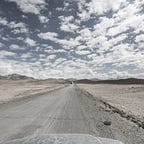Studio D Grant
Last month we offered a travel/writing/research grant for $8k to explore the edge-of-grid. This is who applied, our selection criteria and the winning applicant.
Why Run A Grant?
Studio D has for many years, explored and documented edge-of-grid communities, places with variable access to electricity, water, connectivity, and sometimes, rule of law. Although we run projects the world over, these are the communities where we consistently learn the most about human nature, resilience and, ultimately ourselves. With the affordability of solar power, smartphones and the spread of cellular connectivity, we’re seeing a new wave of interesting emergent behaviours.
We also had selfish motivations to offer the grant: to broaden the Studio’s horizons. After being heads down to deliver two books, template kits and t-h-e-s-e, on top of client projects—it feels like a good time to widen the circle of Studio D hires and collaborators, and devote a month to thinking about what next, what skills we want to bring on board, and why.
The grant/mentorship was enabled by the successful Kickstarter launch of The Field Study Handbook, with the mentorship offered as a stretch goal at $120k and the Studio D Grant, at $250k.
Set Up
$8k is equivalent to a year’s salary in Vietnam or India, or a single month’s salary for an intern in San Francisco. In the right hands it’s four month’s prudent but comfortable travel. It’s enough to take on something meaty.
The grant offers more than money: a mentorship with me (for whatever this is worth), an opportunity to collaborate, potential work opportunities down the line, exposure to network, and attendance of one of our retreats.
The application process was designed to: minimise the time spent applying and assessing the application[1], to give every applicant a fair shot, and expose the Studio to people and topics beyond our current remit. I proactively reached out to communities beyond the studio’s normal network.
One reward stipulation is that the research take place under NDA (even though the results will likely be published), to scare off anyone looking for a trophy project for themselves or their employer. It mostly worked.
Who Applied?
Seventy three people applied for the grant, and nineteen for the mentorship. I personally reviewed every applicant[2], followed links to portfolios, resumes[3], and where things weren’t clear, we followed up with requests for more information.
Of those applicants, around ten are a good fit for Studio D projects today, a similar amount are potential hires with a few years of experience under their belt, and about fifteen pushed me to think beyond what we currently offer, with a potential role for them if we go there.
I was pleased to see applications from across the globe including many of the countries I’ve researched over the years, where the grant money would go a long way. Applicants spanned corporate, nonprofit, freelancers and academia.
Selection Criteria
Viable grant applications/applicants:
- Were interesting, well thought out, and showed maturity in their understanding of the subject matter and its wider implications.
- Could extrapolate into Studio D projects.
- Had a track record of going deep on a single topic [4] and delivering something of recognisable value. This excluded many people early in their career.
We leaned towards applicants with commercial, rather than academic experience. We leaned against people early in their career and with limited travel experience. Applicants scored poorly if they didn’t address the call-to-proposal theme, were overly verbose, or used buzzwords to talk up their proposal.
Project Locations
Project locations spanned the globe: from the Aral Sea in Kazakhstan, to the Western Sahara, equatorial border zones to remote atolls, Canada’s High Arctic to Australia’s Northern Territories, by way of remote Bhutan, Indonesia, Georgia, Chile and China.
Project Themes
Themes spanned conservation to conflict zones, menstruation to blood sacrifices, the notion of home to modern nomadism, brittle economies to resiliency, gift economies to resource extraction. The edge-of-grid was central to some applications, tangental to others.
Who Won?
The winning Grant applicant has been selected and will remain anonymous until we have something to share — probably a year from now. Good things take time. The winner was selected for their vision, skill, quiet confidence born from a track record of delivering interesting projects, and modesty— all things I look for when we hire people onto Studio D projects.
For those that didn’t win the Grant —thank you for applying. If you’re passionate about your project, there are other ways to make it happen. How to make it happen can be spark that leads to a fulfilling career[5]. Best of luck.
We welcome feedback on the process in comments below.
Boot notes:
- Finding the right balance between enjoying the process and the lethargy of admin.
- Every application was reviewed except two applicants who, in side communication, referred to me as their “bro” . Automatically blocked.
- Password protected resumes required an extra step. For some strong applications, a resume was requested by email.
- Not “go deep” in the consultancy sense of spending an afternoon on a subject, but committing to explore an idea for an extended period of time, regardless of obvious payoff.
- Pretty much how my career got going.
